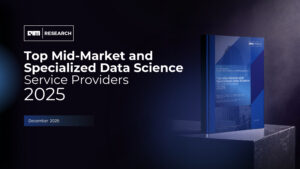The integration of computer vision, digital twin, and generative AI is revolutionizing multiple industries, with a significant impact on retail. By combining these advanced technologies, businesses can enhance the shopping experience, optimize inventory management and gain detailed customer insights for personalized engagement. Let’s briefly explore each of these technologies.
Computer Vision: Computer vision leverages artificial intelligence to enable computers to interpret and understand the visual world. By processing, analyzing, and understanding images or video sequences, computer vision provides comprehensive visual insights.
Digital Twin: Digital twin technology creates a virtual replica of physical objects, processes, or systems. This virtual modeling enables real-time monitoring and simulation, offering insights into performance, potential issues and optimization strategies for physical spaces and operations.
Generative AI: Generative AI is a subset of AI focused on creating content, from text to images and beyond. Its ability to generate realistic simulations and insights based on data inputs makes it a powerful tool for personalization, forecasting, and problem-solving across various applications.
Where does the Transformative Combination lie?
The integration of computer vision, digital twin, and generative AI represents a significant leap forward in technology transformation, facilitating improvements in business operations, especially in the retail sector. This trio offers an experiential retailing approach that enhances the shopping experience through immersive interactions, precise inventory control, insightful customer data analysis, and optimized operational efficiency. It opens several retail opportunities.
- Shopping Experience: Retailers can leverage these technologies to offer immersive shopping experiences, such as enabling customers visualize how home improvement items or furniture would look in their own living spaces through simulations. This not only enhances the shopping experience but also aids in decision-making, potentially increasing sales and customer satisfaction.
- Customer Insights: By combining computer vision’s ability to track foot traffic with a digital twin’s detailed store visualization and generative AI’s analytical prowess, retailers can gain deep insights into customer behavior. This integration allows for the optimization of store layouts, personalized marketing strategies, and improved customer service, leading to a more engaging shopping environment.
- Inventory Management: Computer vision can identify stock shortages, while a digital twin of the store facilitates detailed analysis and planning. Generative AI can further enhance this process by automating restocking procedures and optimizing inventory levels, ensuring that supply always meets demand.
- Supply Chain Optimization: In supply chain management, the combined power of these technologies can significantly reduce inefficiencies. For instance, computer vision can detect product damages, generative AI can automate damage reports and related paperwork, and digital twins can simulate and predict the impact of these damages on the supply chain, enabling proactive measures.
But can this trio impact sectors beyond retail?
While retail offers clear examples of the benefits, these technologies have broader applications.
- Manufacturing: Predictive maintenance is one area where these technologies can significantly improve manufacturing operations. By creating digital twins of machinery and using computer vision to monitor equipment conditions, manufacturers can predict when a machine is likely to fail or require maintenance. Generative AI can then analyze historical maintenance data and current operational parameters to suggest optimal maintenance schedules, reducing downtime and extending equipment lifespan.
- Healthcare: Personalized medicine is another area where the integration of these technologies can lead to significant improvements. By integrating patient data with generative AI and computer vision for medical imaging, healthcare providers can achieve more accurate diagnoses and personalized treatment plans. Digital twins can simulate hospital operations to optimize resource allocation and patient flow, improving care and efficiency.
- Agriculture: Precision farming is an area where these technologies can enable monitoring of crop health, predicting yields, and optimizing resources for improved sustainability and efficiency.
Every innovative approach has its limitations.
The integration of computer vision, digital twin, and generative AI holds the key to unlocking vast improvements across various sectors. However, despite the transformative potential, integrating these technologies comes with challenges around data privacy, the complexity of digital twin construction, and the computational demands of generative AI. Addressing these challenges requires careful planning, ethical considerations, and continuous innovation.
From retail to healthcare, manufacturing, and agriculture, these technologies offer solutions that enhance efficiency, improve outcomes, and drive innovation. As industries continue to evolve, the strategic application of these technologies will be crucial in shaping a future where digital and physical realms are seamlessly integrated, offering unprecedented opportunities for growth and development.






